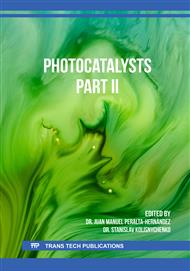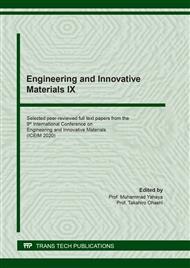[1]
X.C. Dai, M.H. Huang, Y.B. Li, T. Li and F.X. Xiao, Probing the advantageous photosensitization effect of metal nanoclusters over plasmonic metal nanocrystals in photoelectrochemical water splitting, Journal of Physical Chemistry C 124 (2020) 4989-4998.
DOI: 10.1021/acs.jpcc.9b10132
Google Scholar
[2]
R.H. Yuan, H.H. He, J.F. Huang and C. Su, Characterization of interfacial behaviour of ortho-positioned diaryl disulfide on silver substrates by surface-enhanced Raman scattering and electroreduction, Materials Chemistry and Physics 235 (2019) 121726.
DOI: 10.1016/j.matchemphys.2019.121726
Google Scholar
[3]
Y. Zheng, L. Cao, G. Xing, Z. Bai, J. Huang and Z. Zhang, Microscale flower-like magnesium oxide for highly efficient photocatalytic degradation of organic dyes in aqueous solution, RSC Advances 9 (2019) 7338-7348.
DOI: 10.1039/c8ra10385b
Google Scholar
[4]
X.M. Wang, H. Wang, H.F. Zhang, X. Zong and C. Li, Dynamic interaction between methylammonium lead iodide and TiO2 nanocrystals leads to enhanced photocatalytic H2 evolution from HI splitting, ACS Energy Letters 3 (2018) 1159-1164.
DOI: 10.1021/acsenergylett.8b00488.s001
Google Scholar
[5]
M.H. Razali, A.F.M. Noor and M. Yusoff, Physicochemical properties of a highly efficient Cu-ion-doped TiO2 nanotube photocatalyst for the degradation of methyl orange under sunlight, Journal of Nanoscience and Nanotechnology 20 (2020) 965-972.
DOI: 10.1166/jnn.2020.16944
Google Scholar
[6]
R.H. Yuan, F. Huang, J. Jiang, J.F. Huang and C. Su, Monitoring of total volatile organic compound emissions from plastic runway surfaces, Toxicological and Environmental Chemistry 101 (2019) 215-227.
DOI: 10.1080/02772248.2019.1642889
Google Scholar
[7]
L.X. Zhang, L. Rao, R.F. Wang, X. Guo and Y.X. Wang, Fabrication and photocatalytic performance evaluation of hydrodynamic erosion–resistant nano-TiO2–silicone resin composite films, Environmental Science and Pollution Research 26 (2019) 4997-5007.
DOI: 10.1007/s11356-018-4054-z
Google Scholar
[8]
N.K. Sethy, Z. Arif, P.K. Mishra and P. Kumar, Green synthesis of TiO2 nanoparticles from syzygium cumini extract for photo-catalytic removal of lead (Pb) in explosive industrial wastewater, Green Processing and Synthesis 9 (2020) 171-181.
DOI: 10.1515/gps-2020-0018
Google Scholar
[9]
Y. Kurokawa, D.T. Nguyen and K. Taguchi, Nickel-doped TiO2 multilayer thin film for enhancement of photocatalytic activity, International Journal of Materials Science and Engineering 7 (2019) 10-19.
DOI: 10.17706/ijmse.2019.7.1.10-19
Google Scholar
[10]
L. Hlekelele, P. Franklyn, F. Dziike and S.H. Durbach, TiO2 composited with carbon nanofibers or nitrogen-doped carbon nanotubes synthesized using coal fly ash as a catalyst: Bisphenol-a photodegradation efficiency evaluation, New Journal of Chemistry 42 (2018) 4531-4542.
DOI: 10.1039/c7nj04787h
Google Scholar
[11]
S. Khojasteh-Khosro, A. Shalbafan and H. Thoemen, Preferences of furniture manufacturers for using lightweight wood-based panels as eco-friendly products, European Journal of Wood and Wood Products 78 (2020) 593-603.
DOI: 10.1007/s00107-020-01519-8
Google Scholar
[12]
F.L. Braghiroli and L. Passarini, Valorization of biomass residues from forest operations and wood manufacturing presents a wide range of sustainable and innovative possibilities, Current Forestry Reports 6 (2020) 172-183.
DOI: 10.1007/s40725-020-00112-9
Google Scholar
[13]
R. Toczyowska-Mamińska, Wood-based panel industry wastewater meets microbial fuel cell technology, International Journal of Environmental Research and Public Health 17 (2020) 2369.
DOI: 10.3390/ijerph17072369
Google Scholar
[14]
Y. Gu, L. Cheng, Z. Gu, Y. Hong, Z. Li and C. Li, Preparation, characterization and properties of starch-based adhesive for wood-based panels, International Journal of Biological Macromolecules 134 (2019) 247-254.
DOI: 10.1016/j.ijbiomac.2019.04.088
Google Scholar
[15]
N. Ayrilmis, Y.K. Lee, J.H. Kwon, T.H. Han and H.J. Kim, Formaldehyde emission and VOCs from LVLs produced with three grades of urea-formaldehyde resin modified with nanocellulose, Building and Environment 97 (2016) 82-87.
DOI: 10.1016/j.buildenv.2015.12.009
Google Scholar
[16]
Y.F. Miao, F.M. Deng, Y. Chen and H. Guan, Detection of volatile organic compounds released by wood furniture based on a cataluminescence test system, Luminescence 31 (2016) 407-413.
DOI: 10.1002/bio.2974
Google Scholar
[17]
L. Carlsen, R. Bruggemann and B. Kenessov, Use of partial order in environmental pollution studies demonstrated by urban BTEX air pollution in 20 major cities worldwide, Science of the Total Environment 610 (2018) 234-243.
DOI: 10.1016/j.scitotenv.2017.08.029
Google Scholar



